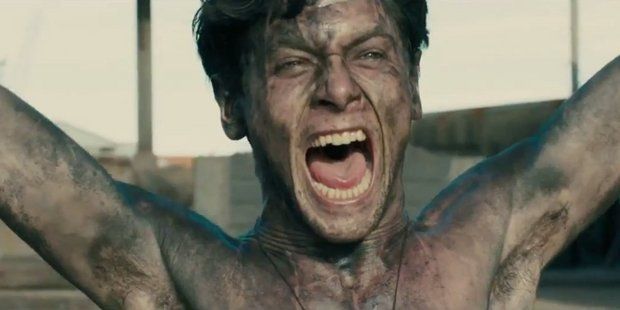That’s the lesson that was drummed into Louis Zamperini’s head from boyhood, back when he was getting picked on by toughs for being Italian, back when he was running track and ready to drop.
“If you can take it, you can make it.” Keep going. Keep running. And if you fall, get up again. Because if you never quit — if you never stop — then you can never really lose.
It got Zamperini to the 1936 Olympics. And later it would take him through getting shot down over the Pacific, drifting for nearly seven weeks in shark-infested waters and more than two years of starvation, forced labor and brutality in a Japanese P.O.W camp.
Just one more day. And then another after that.
This is the relentless, unflagging — and yet, never repetitive — pace of “Unbroken,” a moving, inspirational, slightly safe and comfortably old-fashioned drama from Angelina Jolie.
Based on the Laura Hillenbrand best-seller (with a screenplay assist from a number of good writers, including Richard LaGravanese and the Coen brothers) the film at first cuts between Zamperini’s childhood in Depression-Era California and his career in the U.S. Air Force (he enlisted three months before Pearl Harbor).
Shot through with warm sunlight and a never-cloying attention to period detail, the California scenes – carefully framed, lit and shot – have an unfussy, Hollywood style that brings to mind Clint Eastwood. (Perhaps Jolie was paying more-than-usual attention on the set of “Changeling” back in 2008.)
But as the home and high-schools scenes fade away, and the war takes over, the cutting gets a little more rapid, the angles more dramatic. And then Louis is shot down. And then sharks start circling his flimsy lifeboat.
And then he’s picked up by the Japanese Navy and, impossibly, things get even worse.
Handsome, alert and intensely focused, little-known English actor Jack O’Connell is a fine choice as Louis. And Japanese pop star Takamasa “Miyavi” Ishihara shines as “The Bird,’ Louis’ sadistic captor and war criminal in training.
If the film has a large flaw, it’s that it seems too worried about horrifying us (or losing its PG-13 rating); after tortures which should leave O’Connell little more than a bloody pulp, he sports only a bad black eye and some bruises. But look past that nervousness and you’ll see an interesting, universal relevance here, as Jolie couches the two men’s relationship in the language of domestic abuse.
“Why do you make me hit you?” the captor asks, after pummeling his prisoner unmercifully. Their bonds are those of victor and victim, and yet there are links of emotion and intimacy and dependency here, too; although the sadist doesn’t deserve our sympathy, Jolie suggests that to break the cycle, understanding is necessary as well.
And something more, although it’s not ours to give.
Jolie doesn’t hit this point too hard — except for a sequence with Louis holding aloft a two-by-four, like part of a cross — but faith, and the acceptance that comes with it, was an ever-larger part of Zamperini’s life. And, in fact, it may be the most important part of this film. Because in the end, perhaps survival isn’t the best revenge.
Perhaps forgiveness is.
The best Gossip Magazine Online Gossip Magazine Online
The best travel site Great Vacation Spots Great Vacation Spots
For all your Real Estate needs The Gil Properties




